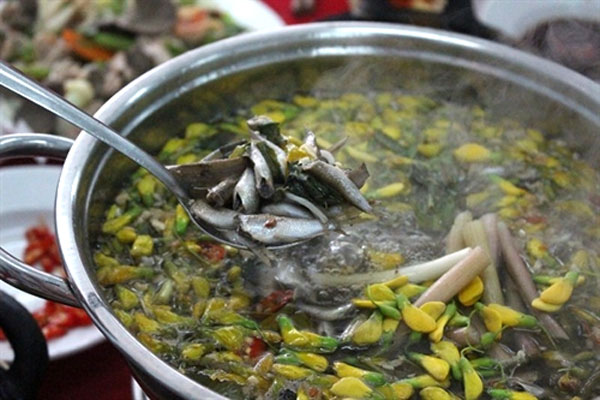VietNamNet Bridge – The southwestern region is well-known for its charming water scenery, so it was not so hard to pick a place to enjoy the weekend.

|
|
Best in rainy season: Boating to explore Bung Binh Thien. -- Photos news.zing.vn
|
I had heard about Bung Binh Thien a long time ago but decided to delay my visit until the monsoon season (July to October according to the lunar calendar) because of the region’s beauty around that time.
From Chau Doc Commune’s downtown, after crossing the An Phu Bridge, a friend and I went to the Khanh Binh gate and then turned left on the crossroads at Quoc Thai to walk two more kilometres to finally reach Bung Binh Thien.
Historically, at the end of the 18th century, a general from the Tay Son dynasty chose Bung Binh Thien as the location to store food and train soldiers. Back then, this region was still arid terrain, so the general held a ceremony imploring the sky and earth gods for rain and water.
After the ritual, the general grasped the hilt of his sword and thrust it into the ground, from where a spring of fresh pure water emerged and gradually turned into the lake it is today. The location was called Bung Binh Thien by the locals. Bung means "lake", Binh means "serene and peaceful" and Thien means "sky".
In fact, there is a big Bung Binh Thien and a smaller one. The big one is 193ha, while the smaller one is only 10ha; the average depth is five metres. In August, the water from the Mekong River from Cambodia rushes to Viet Nam, specifically into the Tien and Hau rivers. The water flows over the river banks into the two lakes and combines into one great big lake covered with lotus, water lilies and water hyacinth.
The level of the crystal clear water of Bung Binh Thien goes up and down according to the seasons. The lake is connected to the Binh Di River, but the river’s reddish seemingly opaque water turns crystal clear blue as soon as it meets the lake.
"Deep below on the floor of the lake, many varieties of algae and kelp help filter the water and prevent torrents. It’s the reason why the lake water is crystal blue all year round." Che Van Toan, a local, shared.
My friend and I feasted our eyes on the lake’s scenery and took in the mellow vibe of the region. We rented a boat to see the water up close and the bushes of bright yellow Egyptian riverhemp in full bloom right on the edge of the water. It seemed like humans and nature were merging into one complete living entity.
"Did you see the Muslim community going to the mosque to pray?" my friend Nguyen Thu Trang asked.
From our boat’s captain, we learned that there are four ethnic groups residing here, namely the Kinh, Hoa, Khmer and Cham groups. The Islamic mosque Mas Jid Khoy Ri Yah has a typical Southwest Asian architectural style: arched roofs and domes with the pointy tops, upside-down U-shaped doors and big columns -- right next to Bung Binh Thien. This mosque is where the Muslim Cham people usually perform their religious rituals.

|
|
Amateur chefs: A henicorhynchus fish hotpot with Egyptian riverhemp - a must-try dish in Bung Binh Thien in the water season.
|
"The mosque is really unique. This is the first time I have seen an architectural style of this kind," I enthusiastically shared with those accompanying me.
We left our boat on the Bung Binh Thien and continued our visit to the over 100-year old Cham village. Here, we encountered some tranquil images: houses built close to each other, the elderly going to the temple, beautiful Cham women in their traditional costumes, children playing on the streets.
Across the village, there were a dozen unique eateries in stilt houses owned by the Cham people. Mostly farmers, these locals work on their farms during the dry season and are amateur cooks offering local specialties during the water season.
The food is simple yet very delicious: snake-head mullet noodles, banh khot (little savory pancakes), banh xeo (sizzling crepes with Egyptian riverhemp filling) and shrimp sauce hotpot with climbing perch, as well as Egyptian riverhemp, water lilies with dipping sauce, henicorhynchus fish patties and stewed henicorhynchus fish with green tamarind for dinner.
Bung Binh Thien brought us one more surprise -- a unique activity held at night by the locals. It was a performance on a floating stage on the lake. Although there was no stage light, we had a special backdrop -- an open water body with patches of floating water hyacinth and a row of bright yellow Egyptian riverhemp as the proscenium.
Having enjoyed a perfect trip to Bung Binh Thien from early morning until the evening, we learned not only of the charming beauty of the region, but also of the simple yet culturally-rich customs of the locals. It reminded us of the human diversity across our country and instilled in us a sense of pride.
| related news |
|
Cham curry – specialty of Cham people in An Giang |
VNS
Cam Tu